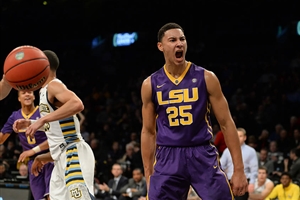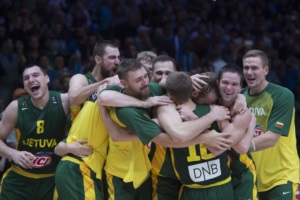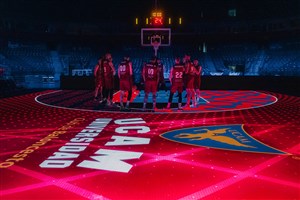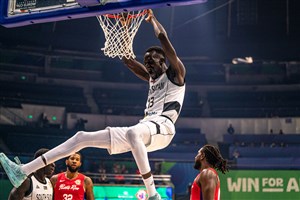
Will this baby go to Rio?
MELBOURNE (Paulo Kennedy's View from Downunder) - OK, so I know it's a bit corny paraphrasing Peter Allen in the headline, but I promise there's a reason for it.
The Boomers have had a lot of success over the years with "the baby" of the team at the Olympics, dating back to before I had even heard of basketball.
The most obvious example is Andrew Gaze, who was controversially picked for the Los Angeles Olympics as a 19-year-old before finishing third on the team with 10.3 points per game.
In 1996, Sam Mackinnon didn't play a lot as a 19-year-old, but showed plenty to give a clear indication of what was to come, while at the same age Andrew Bogut was rock solid in Athens with 13.7 points and 9.0 rebounds per game.
Perhaps Patty Mills was the most precocious tot of all, bursting off the bench in Beijing with four double-figure outings, including 20 points against the USA and 22 on Argentina.
Even more recently on the FIBA Basketball World Cup stage, Dante Exum was taken along for the ride, and even though he was clearly off the pace, that experience will be invaluable when he next pulls on the green and gold.
With all that in mind, you can bet your bottom dollar - and every other dollar - that if Ben Simmons is available he'll be the Boomers' joey at next year's Rio Olympics.
His strong early performances for LSU in US college basketball had generated plenty of hype around the world, it’s not often you get a 2.08m athlete with deft ball skills to match.
The only question really left to answer is what kind of role will he be capable of filling for the Boomers
Of course, those in Australia who see the basketball world as the NBA and nothing else suggest Simmons should be a Boomers starter and go-to guy because 'he's going to be drafted number one'.
When reminded that Exum was drafted number five yet struggled with the international game the retort is usually along the lines of 'Simmons is the next LeBron James'.
Well, at LeBron's first Olympics in 2004 he averaged 5.4 points, 1.6 assists and 1.0 rebounds in 11.5 minutes per night, and that was after his dominant rookie NBA season, not before.
That was on a US team that went 6-3 too, falling to Lithuania, Argentina and Puerto Rico. In that loss to the Central Americans, James had 5 points on 1-of-3 shooting in 13 minutes.
On precedent, the likelihood is Simmons won't be a star, so a better question is can he play the small forward spot against the world’s best three-men?
Well, can he lock-and-trail Klay Thompson, defend Manu Ginobili using a ball-screen, keep up with Rudy Fernandez on a slippery backdoor cut and contain Nicolas Batum? At the offensive end, can he effectively seal strong opponents to make the most of any height mismatches? And does he have the jumpshot needed at the three-spot for an Australian offence lacking stretch bigs?
From what I've seen, he is still at an early stage of development with a number of those fundamentals, short on playing time as a perimeter player to develop them. Given he is playing at power forward for LSU,he might be best suited in that role with a bench unit looking to disrupt defensively and play fast at the other end.
That was where Mills found his niche in 2008, his speed a real point of difference, and for Simmons it could be his combination of speed, length and athleticism at the four-spot. Offensively he could be too slippery for some slower power forwards, allowing him to penetrate and finish at the rim, his undoubted strength at the moment. He could also be a handful crashing the offensive glass, and his ability to rebound and trigger transition is perfectly suited to the Boomers style.
But to play that role he is going to have to make some serious progress in the next eight months defending the ball-screen. In the fourth quarter against North Florida, when LSU were weathering a late run, Simmons' opponent set a high ball-screen in transition, which the young Aussie completely misread and jumped to the wrong side, opening up a direct lane to the basket. Simmons then missed his rotation when the ball was kicked to the perimeter and gave up a wide-open triple. That was probably the worst example, but there were many others where his ball-screen defence was exploited badly as North Florida ran up 108 points.
In the international game, even a few minutes of these sorts of breakdowns is likely to cost the Boomers defeat against the world’s best teams. Remember, it was ultimately Australia's opening day 10-point loss to Slovenia that cost them top spot in their group at Spain 2014. In that game Exum played 11 minutes and the Boomers were outscored by nine points in that time.
Just as importantly, if Simmons is going to play in a disruptive pressure defence, he's going to have to get his angles, locations and reads spot on - and be able to make them at high-speed - or the Boomers will be giving up lay-ups.
So back to the question, can he make an impact in Rio?
His pure physical performances so far at LSU tell you it's definitely possible, but his fundamentals at both ends of the court need to improve markedly. The beauty of that is Simmons will play against some of the best college teams over the next few months, building something of a bridge between what he's faced so far and the elite company he’ll take on at the Olympics.
How far he makes it across the chasm is up to him.
Paulo Kennedy
FIBA
FIBA's columnists write on a wide range of topics relating to basketball that are of interest to them. The opinions they express are their own and in no way reflect those of FIBA.
FIBA takes no responsibility and gives no guarantees, warranties or representations, implied or otherwise, for the content or accuracy of the content and opinion expressed in the above article.


















